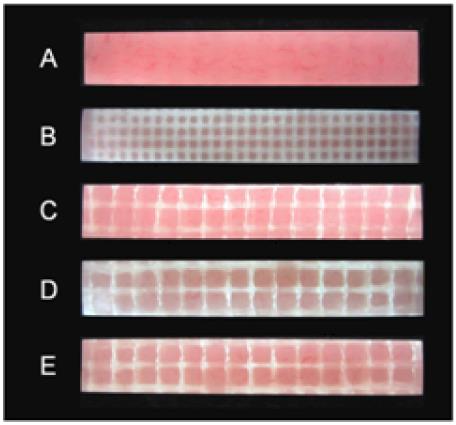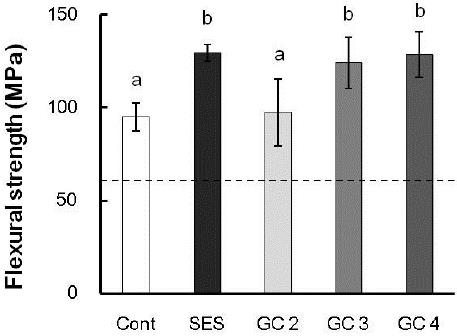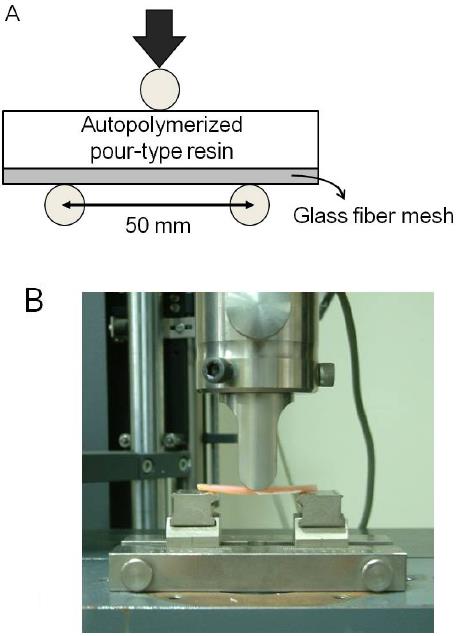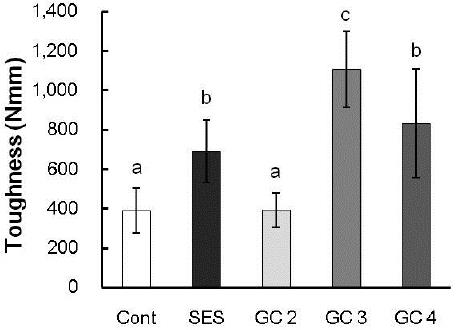
Reinforcing effect of glass fiber mesh with different content and structures on autopolymerized pour-type denture base resin
The aim of this study was to evaluate the reinforcing effects of glass fiber meshes with different content and structures on auto-polymerized pour-type denture base resin. The reinforcements were two types of glass fiber meshes; SES mesh(SES: SES 1108, INNO Dental Co., Ltd., Korea) and Glass cloth(GC: Glass cloth R 326, Hankuk Fiber Co., Korea). GC groups were prepared in two layers(GC 2), three layers(GC 3), and four layers(GC 4). Auto-polymerized pour-type resin(PRESS LT; retec, Rosbach, Germany) was used as the denture base resin. The specimen(64×10×3.3 mm) was prepared by locating each reinforcement at the tension side of the three-point bending mode. Control group was prepared without any reinforcement. The flexural properties of the specimen were measured by an universal testing machine at a crosshead speed of 5 mm/min. The results were evaluated with 1-way ANOVA, and the Duncan's multiple range test(=0.05). The flexural strength and toughness of all the glass fiber reinforced groups were significantly higher than the control, except GC 2(P<0.05) and GC 3 showed the highest toughness(P<0.05). The flexural moduli of all the glass fiber reinforced groups were significantly higher than the control(P<0.05). SES(4.36 vol%), GC 3(5.34 vol%) and GC 4(7.39 vol%) were effective in reinforcing the flexural properties of the denture base resin and GC 3 was most effective. Content of the glass fiber reinforcement is considered to be a more important factor than the structure.
Keywords:
Fiber-reinforced composite (FRC), Glass fiber mesh, Denture base resin, Flexural properties서 론
치과보철 분야에서 총의치나 가철성 국소의치상 제작에 주로 사용되고 있는 의치상용 폴리머(denture base polymers)의 파절을 방지하고, 의치상을 강화하는 방법으로 최근 관심이 집중되고 있는 것이 섬유강화 복합재료(fiber-reinforced composite: FRC)이다(유 등, 2012; Kanie 등, 2002; Narva 등, 2005). FRC는 레진에 분상상(dispersed phase)인 섬유를 결합시킨 형태의 복합재료로 레진기질의 기계적인 성질을 강화시킨다(Bae 등, 2004; Callster, 2007). FRC에 이용할 수 있는 섬유는 탄소(carbon) 섬유(Ekstrand 등, 1987; Yazdanie와 Mahood, 1985), 초고분자량 폴리에틸렌(Ultra high molecular weight polyethylene; UHMWPE) 섬유(Karacaer 등, 2001; Gutteridge, 1992), 폴리아로마틱 폴리아마이드(polyaromatic polyamide; 아라미드) 섬유(Berrong 등, 1990), 유리 섬유 등 다양하다(Vallittu, 1999; Vallittu와 Narva, 1997; Kanie 등 2000). 특히 유리 섬유는 세포독성이 없고, 심미적이어서 post, splint, fixed prosthetic 등과 같은 치과분야에서 다양하게 적용되고 있다(Bae 등, 2001; Song 등, 2003; Yenisey와 Kulunk, 2008). 또한 의치상용 레진의 굴곡 성질과 충격강도를 향상시켜는 것으로 보고되고 있으며, 다른 섬유에 비해 강화효과가 뛰어나 많은 연구가 이루어지고 있다(Uzun 등, 1999; Doğan 등, 2008).
FRC의 물성은 첨가한 섬유의 종류, 섬유의 길이와 함량, 섬유의 위치, 섬유의 배열 방향성과 형태에 따른 구조 등에 의해 영향을 받게 된다(Vallittu, 1999; Uzun 등, 1999; Doğan 등, 2008; Karacaer 등, 2003). 레진 기질에 첨가하는 유리섬유 강화재는 단방향(unidirectional) 구조, 양방향(bidirectional) 구조, 특별한 방향성이 없는(random) 구조로 적용된다(Vallittu, 1993). 단방향 유리 섬유는 1,000-2,000 가닥의 단일 섬유 가닥들로 구성되어 있으며, 양방향의 직물(mesh) 구조는 평직(plain), 능직(twill), 주자직(satin)과 같이 다양한 짜임으로 제작할 수 있다(Vallittu, 1993; Chong, 2003). 유리섬유 직물은 단방향 구조보다 가위로 쉽게 자를 수 있어 레진 기질에 첨가 시 조작이 용이하며, 쉽게 형태를 만들 수 있다(Kanie 등, 2004; Vallittu, 1999). 지금까지 시행된 이전의 연구들은 주로 단방향 구조의 섬유를 첨가하거나, 동일한 직물 구조의 섬유 강화재를 첨가하여 실험을 진행하였고, 단방향과 양방향 구조의 유리섬유 강화재를 적용시켰을 때 강화효과의 차이를 비교한 연구들이 대부분이었다(Kanie 등, 2000; Chong과 Chai, 2003; Vallittu, 1999).
따라서 본 연구에서는 구멍이 있는 망사구조인 유리섬유 mesh에 대하여 서로 다른 구조와 함량에 따른 유동성 자가중합 레진의 강화효과를 비교하기 위하여, 시편 제작 시 구조가 다른 두 종류의 유리섬유 mesh와 3가지로 함량을 달리하여 섬유 강화재의 구조와 함량에 따른 유동성 자가중합 레진의 강화효과를 평가하고자 하였다.
재료 및 방법
1. 실험재료
본 연구에서 시편제작 시 사용한 의치상용 폴리머는 ISO 20795-1:2008 (Dentistry–Base polymers–Part 1: Denture base polymers) 제 2형 자가중합형, 2급 유입형 폴리머(Type 2 Class 2 pour-type resin) (PRESS LT; retec, Rosbach, Germany)이었다. 시편의 강화에 사용된 두 가지 형태의 유리섬유 mesh는 SES mesh(SES)와 glass cloth(GC)이었다(Table 1). SES mesh는 레진 기질에 미리 적셔져 공급되었다. Glass cloth는 각각 2겹(GC 2), 3겹(GC 3), 4겹(GC 4)으로 만든 상태에서 실험실에서 자체 제작한 bisphenol A-glycidyl dimethacrylate(bis-GMA) 제재의 레진, 즉, bis-GMA(NK Oligo, EMA-1020), urethane dimethacrylate(UDMA; Aldrich, MO, U.S.A), triethylene glycol dimethacrylate (TEGDMA; Aldrich, MO, U.S.A), camphorquinone, dime-thylaminoethyl methacrylate(DMAEMA; Aldrich, MO, U.S.A) 등을 혼합하여 제작한 레진에 담가 준비하였다(Kim 등, 2011).
2. 시편제작
시편제작은 국제표준 제 20795-1호(ISO 20795-1:2008)의 굴곡시험방법 따라 시행하였다. 길이 65 mm × 폭 40 mm × 깊이 5 mm의 황동판을 이용하여 의치용 플라스크에 석고 음형을 형성하였다. 레진에 적셔져 있던 SES는 해당 회사에서 추천하는 광중합기(DENSTAR-300; Denstar, Daegu, Korea)로 중합하였고, GC는 일반 광중합기(VisioTM Beta Vario, 3M ESPE, Seefeld, Germany)로 중합하였다. 중합된 유리섬유 mesh를 길이 64 mm × 폭 40 mm이 되도록 잘라 음형의 하방에 위치시키고, 나머지 부위를 유동성 자가중합 레진를 제조자의 지시대로 분말 20 g/액 14 g으로 1분간 혼합한 후 채워주었다. 레진이 전입된 플라스크를 45℃의 물이 담긴 2.2 bar의 압력이 가해지는 압력솥에 넣어 1시간동안 중합하였다. 중합이 끝난 후 플라스크에서 제거한 시편을 순차적으로 연마하여 길이 64 mm × 폭 10 mm × 두께 3.3 mm의 시편이 되도록 제작하였다(Figure 1). 대조군으로 유리섬유 mesh를 넣지 않은 시편(Control)도 제작하였으며, 각 군당 시편 수는 10개씩이었다.

Photographs of the completed rectangular-shaped specimens with the size of 64 × 10 × 3.3 mm. A, Control group. B. Specimen reinforced with SES glass mesh (SES). C, Specimen reinforced with two layers glass fiber cloths (GC 2). D, Three layers glass fiber cloths (GC 3). E, Four layers glass fiber cloths (GC 4).
시편에 첨가한 유리섬유 mesh의 함량은 소환로(Ring furnace; SEKI dental, Seoul, Korea)를 이용하여 연소분석법으로 측정하였으며, 700℃의 소환로에서 1시간 동안 유지시키기 전후의 유리섬유의 무게와 각 유리섬유 mesh의 밀도를 Density Determination Kit(YDK01, Sartorius, Goettingen, Germany)로 측정하여 계산하였다. 측정된 유리섬유 mesh의 부피비는 Table 1과 같다.
3. 3점 굴곡강도 시험
제작된 시편은 굴곡시험 전까지 (37 ± 1)℃에서 (50 ± 2) 시간 동안 밀폐된 용기 내에 증류수를 담아 보관하였다. 지지대간의 거리는 50 mm, cross head speed는 5 mm/min 이었다(Figure 2). 굴곡강도, 굴곡계수와 인성은 만능시험기 내의 프로그램(TestXpert 11.0, Zwick, Ulm, Germany)에 의해 계산되었다. 굴곡강도(σ)와 굴곡계수(E)의 계산식은 ISO 20795-:2008에 따라 다음과 같다.
4. 파절양상
시편의 파절양상은 2가지로 분류하였다. 레진층과 섬유 강화재 부분이 모두 끊어져 시편이 완전 파절된 경우 A로 분류하였다. 레진층은 모두 파절되고, 섬유 강화재 부분에서 약간의 파절이 일어난 경우 B로 분류하였다(Figure 3).
5. 통계분석
통계분석은 SPSS 프로그램(SPSS 12.0; SPSS GmbH, Munich, Germany)을 이용하였다. 모든 실험군과 대조군의 굴곡성질을 one-way ANOVA로 신뢰수준 95%에서 분석하였고, 사후검정으로 Duncanʹs multiple range test를 시행하였다.
결 과
1. 굴곡강도
굴곡강도의 경우 GC 2를 제외하고, 유리섬유 mesh를 첨가한 모든 실험군이 대조군에 비해 유의성 있게 증가하였다(P<0.05), (Figure 4). SES, GC 3, GC 4의 굴곡강도는 대조군에 비해 121%~125% 증가하였다. 굴곡강도는 대조군과 모든 실험군이 ISO 20795-1:2008의 제 2형 자가중합형 폴리머의 중합체 기준치인 60 MPa보다 높게 나타났다.

Flexural strength of the denture base resin without (Cont) and with glass fiber reinforcements(SES and GC). The superscripts with the same letters were not significantly different by 1-way ANOVA and Duncan's multiple range test at α=.05. *Dotted line is the minimum requirements of autopolymerizing denture base resin of ISO 20795-1:2008.
2. 굴곡계수
굴곡계수는 모든 실험군이 대조군보다 유의성 있게 높았고(P<0.05), 실험군의 굴곡계수는 대조군보다 130%~ 136% 증가하였다(Figure 5). 대조군과 모든 실험군이 모두 1.5 GPa보다 높게 나타나 ISO 20795-1:2008의 제 2형 자가중합형 폴리머의 중합체 기준치를 만족시켰다.

Flexural modulus of the denture base resin without (Cont) and with glass fiber reinforcements(SES and GC). The superscripts with the same letters were not significantly different by 1-way ANOVA and Duncan's multiple range test at α=.05. *Dotted line is the minimum requirements of auto-polymerizing denture base resin of ISO 20795-1:2008.
3. 인성
인성의 경우 SES, GC 3, GC 4가 대조군과 GC2보다 유의성 있게 높았으며, GC 3은 가장 높은 인성을 보였다(P<0.05), (Figure 6). GC 3의 인성은 대조군에 비해 284% 높게 나타났고, GC 4는 213%, SES는 177% 증가하였다.
고 찰
본 연구에서는 유리섬유 mesh의 구조와 함량에 따른 유동성 자가중합 레진의 강화효과를 비교하고자, SES 와 2겹, 3겹, 4겹의 GC(GC 2, GC 3, GC 4)를 첨가하여 유동성 자가중합 레진의 굴곡성질을 가장 효과적으로 증가시키는 조건을 찾고자 하였다. 유동성 자가중합 레진의 굴곡강도와 인성의 경우 SES, GC 3, GC 4가 유의성 있게 증가하였고, 특히 GC 3를 첨가한 경우 대조군에 비해 인성이 284% 증가하여 가장 뛰어난 강화효과를 보였다. 굴곡계수의 경우 유리섬유 mesh를 첨가한 모든 실험군이 대조군에 비해 130-136% 증가하여 유의성 있게 높게 나타났다.
ISO 20795-1:2008에서 제 2형 자가중합형 폴리머의 중합체의 굴곡강도는 최소 60 MPa, 굴곡계수는 최소 1.5 GPa로 규정하고 있다. 본 연구에서 대조군과 GC 2의 굴곡강도는 각각 95.03 MPa, 97.34 MPa, 나머지 실험군은 모두 120 MPa이상으로 나타나 국제표준 기준치를 모두 만족시켰다. 굴곡계수의 경우 대조군은 2.63 GPa으로 나타나 국제표준 기준치를 만족시켰고, 실험군의 경우 모두 3.0 GPa이상으로 나타나 국제표준 기준치의 2배 이상을 증가시켰다.
섬유강화재의 물성에 영향을 주는 인자로는 섬유의 종류, 섬유의 직경과 길이, 섬유와 레진의 함량비 등이 있다(Yu 등, 2012; Uzun 등, 1999; Doğan 등, 2008; Karacaer 등, 2003). 본 연구에서도 유리섬유 강화재의 함량에 따라 그 강화효과가 달라지는 것을 확인할 수 있었다. 본 연구에서 비교적 섬유의 함량이 적었던 GC 2(3.43%)은 대조군과 유사한 굴곡강도와 인성을 보였으며, 가장 높은 인성을 나타낸 GC 3의 함량은 5.34%이었다. 이전에 시행한 연구에서도 2.6%, 5.3%, 7.9%로 단방향 유리섬유 강화재를 첨가하여 열중한 의치상용 레진의 강화효과를 평가한 결과, 5.3% 부피로 유리섬유 강화재를 첨가하였을 때 굴곡성질이 가장 높게 나타났다(Yu 등, 2012). 이러한 결과를 통해 의치상용 레진 시편의 강화에 적당한 유리섬유 강화재의 함량은 5.3% 라고 사료된다.
유리섬유 강화재 중 부피비가 유사했던 GC 3과 SES의 결과를 보면 인성에서 GC 3가 SES보다 높게 나타난 것을 제외하고 굴곡강도와 굴곡계수에서 서로 유의성 있는 차이가 없는 것으로 나타났다. SES와 GC는 섬유 직물의 짜임 구조가 달랐으며, mesh에 형성된 구멍의 크기 또한 차이가 있었음에도 이러한 결과를 보인 것은 유리 섬유 강화재의 구조보다 함량이 더 큰 영향을 미쳤기 때문으로 사료된다. 본 연구에서는 구멍이 있는 망사형태의 직물구조인 mesh type을 사용하였다. 촘촘한 직물구조인 경우 의치상용 레진이 직물사이로 침투가 용이하지 못해 결합력이 떨어져 강화효과가 별로 없다는 것을 예비실험에서 확인하였기 때문이다. 폴리아라미드 섬유나 UHMWPE 섬유의 경우, 촘촘한 직물구조는 있지만 mesh 형태의 구조가 없어 본 실험에 사용하지 못하였다.
뿐만 아니라 SES의 경우 PMMA 레진으로 미리 적셔져 있었고, GC의 경우 실험실에서 자체 제작한 bis-GMA 레진으로 적신 후 전중합하여 시편에 첨가하였다. 그러나 서로 다른 레진 기질로 미리 적신 SES와 GC는 인성에서 GC 3가 SES보다 높게 나타난 것을 제외하고는 굴곡강도와 굴곡계수에서 유의한 차이를 보이지 않았다. 섬유 강화재를 미리 적셔 의치상 레진에 첨가하는 경우 다공성의 PMMA 레진이나 광중합 레진을 주로 사용하게 되는데, Vallittu(1999)는 폴리머와 모노머가 혼합된 다공성 PMMA 레진 혼합물로 미리 적시는 경우 섬유 강화재가 잘 침전되어 치밀한 섬유 복합재 구조를 형성된다고 하였다. 교차결합을 하는 dimethacrylate 폴리머 기질은 PMMA 레진과 함께 IPN(interpenetrating polymer network)을 형성하지 않기 때문에 PMMA 레진의 강화에 사용될 수 없으나, bis-GMA 레진의 경우 MMA를 용해시켜 미리 적신 bis-GMA와 시편제작 시 사용한 PMMA 계열의 유동성 자가중합 레진의 결합을 유도했기 때문에 PMMA 레진과 bis-GMA 레진에서 결과에 차이가 나타나지 않았던 것으로 사료된다.
파절양상의 경우 인성에서 가장 높은 강화효과를 보였던 GC 3의 경우 레진부분은 모두 파절되었으나 유리섬유 강화재 부분이 부분파절을 보여 시편이 완전히 파절되지 않았다. 다른 시편의 경우 레진부분과 섬유 강화재 부분이 모두 파절되어 시편이 완전히 두 조각으로 끊어진 것이 대부분이었다. 인성이 가장 높았던 GC 3의 경우 부분파절 양상도 가장 많이 나타났다.
섬유 강화재의 효과를 평가한 기존의 연구는 ISO 20795-1:2008의 굴곡시험 측정방법에 따라 직육면체 형태(65 x 10 x 3.3 mm)의 시편으로 제작하여 평가하는 경우가 대부분이었다. 유동성 자가중합 레진를 이용하여 제작하게 되는 가철성 의치의 경우 인공치를 포함하고 있고, 복잡한 3차원적인 구조이기 때문에 직육면체 형태의 시편으로 시험된 결과와 다를 수 있다. 그러므로 추후 연구에서는 실제 구강 내에 들어가는 가철성 의치의 형태로 제작된 시편에 적용하여 직육면체 형태의 시편 결과와 비교해 볼 필요가 있다.
본 연구를 통해서 다양한 함량과 구조를 가진 유리섬유 mesh가 유동성 자가중합 레진의 굴곡성질을 증가시키는데 효과가 있었다. 섬유 강화재의 함량이 유동성 자가중합 레진의 강화효과에 영향을 미치는 중요한 요인이며, 가장 효과적인 섬유의 함량은 4.36-7.39%이었다. 특히 5.34% 부피비의 유리섬유 mesh가 유동성 자가중합 레진의 인성을 증가시키는데 가장 효과적임을 확인할 수 있었다.
결 론
본 연구는 유동성 자가중합 레진에 구조와 함량이 다른 SES, GC 2, GC 3, GC 4의 유리섬유 mesh를 첨가하여, 섬유 강화재의 구조와 함량에 따른 강화효과를 평가하였다.
1. SES와 GC 3, GC 4는 유동성 자가중합 레진의 굴곡강도, 굴곡계수, 인성을 유의성 있게 증가시켰다(P<0.05).
2. Mesh 형태의 유리섬유 강화재에서 구조보다는 함량이 유동성 자가중합 의치상용 레진의 강화에 영향을 미치는 중요한 요인이었다.
3. 가장 효과적인 유리섬유 mesh의 함량은 5.34%였다.
Acknowledgments
이번 연구를 위해 유리섬유를 제공해주신 (주)한국화이바(밀양, 대한민국), (주)이노디(연천, 대한민국)에 감사드립니다.
Notes
References
- 상희 유, 다령 박, 승한 오, 지명 배, 섬유의 종류와 배열방향에 따른 상악 총의치의 강화효과, 대한치과기재학회지, (2012), 39, p63-72.
- JM Bae, KN Kim, M Hattori, K Hasegawa, M Yoshinari, E Kawada, Y Oda, The flexural properties of fiber-reinforced composite with light-polymerized polymer matrix, Int J Prothodont, (2001), 14, p33-9.
-
JM Bae, KN Kim, M Hattori, K Hasegawa, M Yoshinari, E Kawada, Y Oda, Fatigue strengths of particulate filler composites reinforced with fibers, Dent Mater J, (2004), 23, p166-174.
[https://doi.org/10.4012/dmj.23.166]

- JM Berrong, RM Weed, JM Young, Fracture resistance of Kevlar- reinforced poly(methyl methacrylate) resin: a preliminary study, Int J Prosthodont, (1990), 3, p391-395.
- WD Callister, Materials science and engineering: an introduction. Wiley Asia student edition, 7th ed. Asia: John Wily & Son, (2007), p595-607.
- KH Chong, J Chai, Strength and mode of failure of unidirectional and bidirectional glass fiberreinforced composite materials, Int J Prosthodont, (2003), 16, p161-6.
- OM Doğan, G Bolayir, S Keskin, A Doğan, B Bek, The evaluation of some flexural properties of a denture base resin reinforced with various aesthetic fibers, J Mater Sci Mater Med, (2008), 19, p2343-9.
-
K Ekstrand, IE Ruyter, H Wellendorf, Carbon/ graphite fiber reinforced poly(methyl methacrylate): properties under dry and wet conditions, J Biomed Mater Res, (1987), 21, p1065-1080.
[https://doi.org/10.1002/jbm.820210902]

- International Organization for standardization, ISO 20795-1. Dentistry - Base polymers-Part 1: Denture Base Polymers, ISO, Geneva, (2008).
-
T Kanie, K Fujii, H Arikawa, K Inoue, Flexural properties and impact strength of denture base polymer reinforced with woven glass fibers, Dent Mater, (2000), 16, p150-158.
[https://doi.org/10.1016/S0109-5641(99)00097-4]

-
T Kanie, H Arikawa, K Fujii, Impact strength of acrylic denture base resin reinforced with woven glass fiber, Dent Mater J, (2003), 22, p30-38.
[https://doi.org/10.4012/dmj.22.30]

-
T Kanie, H Arikawa, K Fujii, S Ban, Flexural properties of denture base polymers reinforced with a glass cloth-urethane polymer composite, Dent Mater, (2004), 20, p709-16.
[https://doi.org/10.1016/j.dental.2003.11.007]

- O Karacaer, OM Dogan, T Tinçer, A Dogan, Reinforcement of maxillary dentures with silanetreated ultra high modulus polyethylene fibers, J Oral Sci, (2001), 43, p103-107.
-
O Karacaer, Tn Polat, A Tezvergil, LV Lassila, PK Vallittu, The effect of length and concentration of glass fibers on the mechanical properties of an injection- and a compression-molded denture base polymer, J Prosthet Dent, (2003), 90, p385-93.
[https://doi.org/10.1016/S0022-3913(03)00518-3]

- MJ Kim, WC Jung, S Oh, M Hattori, M Yoshinari, E Kawada, Y Oda, JM Bae, Flexural properties of three kinds of experimental fiberreinforced composite posts, Dent Mater J, (2011), 30, p38-44.
-
KK Narva, LV Lassila, PK Vallittu, The static strength and modulus of fiber reinforced denture base polymer, Dent Mater, (2005), 21, p421-8.
[https://doi.org/10.1016/j.dental.2004.07.007]

-
HY Song, YJ Yi, LR Cho, DY Park, Effects of two preparation designs and pontic distance on bending and fracture strength of fiber-reinforced composite inlay fixed partial dentures, J Prosthet Dent, (2003), 90, p347-53.
[https://doi.org/10.1016/S0022-3913(03)00434-7]

-
G Uzun, N Hersek, T Tinçer, Effect of five woven fiber reinforcements on the impact and transverse strength of a denture base resin, J Prosthet Dent, (1999), 81, p616-20.
[https://doi.org/10.1016/S0022-3913(99)70218-0]

-
PK Vallittu, Comparison of two different silane compounds used for improving adhesion between fibres and acrylic denture base material, J Oral Rehabil, (1993), 20, p533-9.
[https://doi.org/10.1111/j.1365-2842.1993.tb01640.x]

-
PK Vallittu, Flexural properties of acrylic polymers reinforced with unidirectional and woven glass fibers, J Prosthet Dent, (1999), 81, p318-326.
[https://doi.org/10.1016/S0022-3913(99)70276-3]

- PK Vallittu, KK Narva, Impact strength of a modified continuous glass fiber-poly(methyl methacrylate), Int J Prosthodont, (1997), 10, p142-148.
- N Yazdanie, M Mahood, Carbon fiber acrylic resin composite: an investigation of transverse strength, J Prosthet Dent, (1985), 54, p543-547.
-
M Yenisey, S Kulunk, Effects of chemical surface treatments of quartz and glass fiber posts on the retention of a composite resin, J Prosthet Dent, (2008), 99, p38-45.
[https://doi.org/10.1016/S0022-3913(08)60007-4]

-
SH Yu, Y Lee, S Oh, HW Cho, Y HW, JM Bae, Reinforcing effects of different fibers on denture base resin based on the fiber type, concentration, and combination, Dent Mater, (2012), 31, p1039-46.
[https://doi.org/10.4012/dmj.2012-020]





